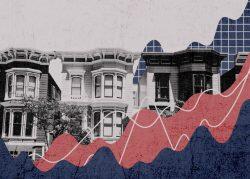San Francisco Mayor London Breed is pondering a reduction in affordable housing requirements to spur stalled residential development in the city.
With new housing development in the city at a near standstill, Breed is looking to cut affordable requirements or defer fees to get residential building job sites up and running again, the San Francisco Chronicle reported.
To address the problem, the Mayor’s Office called for the reconvening of a “technical advisory committee” to revisit the city’s inclusionary affordable housing program, which requires market-rate developers to either include affordable units, pay a fee or dedicate land.
The eight-person committee, which includes four mayoral and four Board of Supervisors appointees, hasn’t met since February 2018.
The push comes as the city experiences declines in housing production: fewer new buildings are opening; active construction is way down; applications for projects have plummeted.
At a recent Planning Commission meeting, city economist Ted Egan and Land Use Program Manager Joshua Switzky delivered a mostly grim outlook for future housing development as well as office occupancy in Downtown San Francisco.
This year, San Francisco completed 1,161 housing units, putting the city on pace to see fewer than 3,000 new homes. Last year, the city developed 4,649 housing units.
There are 4,100 units under construction, compared to a high of 10,000 units being built in 2016 or 2017. This year, the city has approved about 800 units, with 2,000 projected by year’s end — about half the 10-year average.
Meanwhile, tens of thousands of approved units are languishing as the cost of building has outpaced revenues that can be generated through rents or sales. Rents in San Francisco are still 14 percent below what they were pre-pandemic, while construction costs have gone up, Egan said.
Developers still have to pay a range of fees, depending on the size of the project, where it is located and whether the builder is taking advantage of any of the “density bonus” programs.
Sarah Dennis-Phillips, a senior director for Tishman Speyer, said its most recent building, the 392-unit Mira that opened in 2020, wouldn’t work financially today. Tishman Speyer has an approved project at the former Creamery cafe in South of Market, but that project isn’t feasible.
“The costs are simply too high to generate an acceptable return,” said Dennis-Phillips, who is also on the committee looking into fees.
Much of the city’s housing pipeline remains clogged. There are 14 projects of 2,257 units entitled in 2018 or 2019 that have not started construction. While progress is being made on two phased mega-projects — Treasure Island and Mission Rock — several major projects remain in limbo.
They include a 6,000-unit expansion of Parkmerced, 12,000 units at the Shipyard and Candlestick Point, and 1,679 units at Schlage Lock. In addition, the 8,550 units expected to be generated in large projects alongside the future Central Subway are stalled.
Developer Eric Tao, on the committee looking at fees and requirements, hoped for a repeat of 2010, during the Great Recession, when late Mayor Ed Lee brought together developers, building trades leaders, lawmakers and advocates to figure out how to restart construction.
The city opted to lower affordable housing requirements and defer 80 percent of fees so developers paid when residents moved into a building, rather than when construction permits were obtained.
[San Francisco Chronicle] – Dana Bartholomew
Read more


